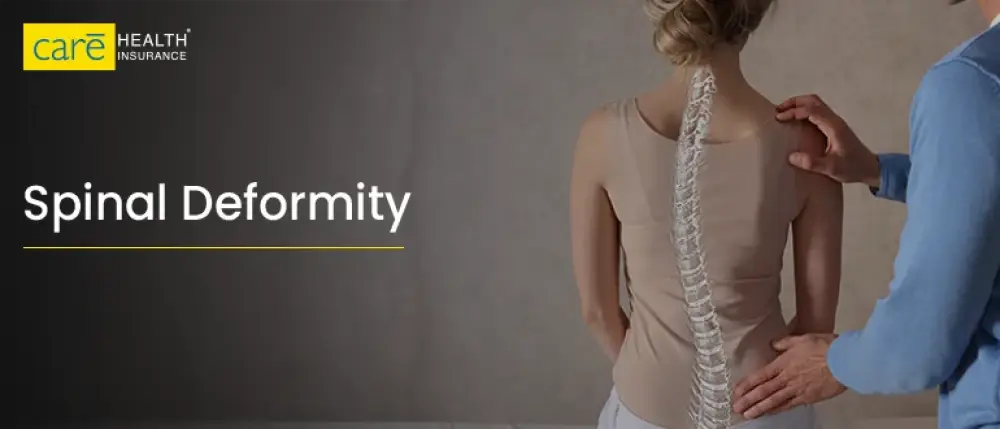Subscribe to get weekly insights
Always stay up to date with our newest articles sent direct to your inbox
Published on 11 Aug, 2025
Updated on 13 Aug, 2025
89 Views
5 min Read

Written by Yash
Reviewed by Ritika Malik
favorite0Like
favoriteBe the First to Like
Spinal deformity refers to an abnormal curvature or alignment of the spine. It occurs when your spine varies by more than 10 degrees from healthy curvature. In a healthy spine, there are natural curves that help balance the body and absorb shock. Minor spinal deformities may only require monitoring of the condition.
The spine is naturally curved in specific ways to support posture, movement and balance. However, in spinal deformities, these curves become exaggerated or develop in the wrong direction, affecting not only appearance but also function, including pain, nerve problems, or even breathing difficulty in severe cases.
Spinal deformities are categorised into various types, such as:
Scoliosis is an abnormal side-to-side curvature of your spine. Your spine naturally has a slight forward and backwards curve. With scoliosis, your spine curves to the left and right into a C or S shape. This differs from your body’s natural front-to-back curve.
Lordosis is the medical definition for the forward curved spine in your neck or lower back. This type develops if your spine curves too much and pushes your posture out of its usual alignment. This condition is often referred to as a swayback due to a noticeable arch in the lower back, causing the stomach and buttocks to stick out more than usual.
Kyphosis is an excessive forward curve of your spine. This causes your upper back, around the thoracic region, to bend forward. This condition can cause you to lean forward like you’re hunching over. People sometimes call it a hunchback or a roundback. It might cause back pain and stiff muscles.
Kyphosis can be classified into different types based on its cause and effects. Understanding these types is essential for proper diagnosis and effective treatment.
The symptoms can vary based on the severity of the curvature and whether there is spinal cord involvement. A comprehensive overview of the symptoms includes:
It’s important to note that the presence and severity of these symptoms can vary widely among individuals with congenital kyphosis. Early detection and regular monitoring are crucial to managing the condition effectively and preventing potential complications. If any of these symptoms are observed, especially neurological signs or respiratory difficulties, prompt medical evaluation is essential.
Understanding the underlying causes is essential for early diagnosis and intervention, which can help manage the progression of congenital kyphosis and improve outcomes for affected individuals. A detailed understanding of its causes includes:
Early detection is crucial for effective management. Diagnosing congenital kyphosis involves a comprehensive approach to accurately assess the spinal deformity and its impact on the patient’s health. Additionally, the diagnostic process typically includes:
Early and accurate diagnosis of congenital kyphosis is vital for effective management and to prevent potential complications. A multidisciplinary approach, often involving orthopaedic surgeons, neurologists, and radiologists, ensures a thorough evaluation and the development of an appropriate treatment plan tailored to the patient’s specific needs.
>> Also Read: Does Health Insurance Cover Spinal Fusion?
Treatment of kyphosis depends on its types, severity and symptoms a person is experiencing. Here are some of the treatment options that any health expert might involve to treat the condition:
Recognising types of back deformities early can help prevent long-term pain and complications. Whether it’s postural kyphosis or congenital kyphosis in adults, knowing the signs and treatments makes all the difference. Congenital kyphosis is a spinal condition present from birth that, if left untreated, can progress and impact a child’s overall health and quality of life.
Disclaimer: The above information is for reference purpose only. Plan features, benefits, coverage, and underwriting claims are subject to policy terms and conditions. Please refer to the brochure, sales prospectus, and policy documents carefully.
favoriteBe the First to Like
Thyroid : मामूली नहीं हैं महिलाओं में थायराइड होना, जानें इसके लक्षण और घरेलू उपचार Vipul Tiwary in Diseases
शुगर कंट्रोल कैसे करे? जानें, डायबिटीज में क्या खाना चाहिए Vipul Tiwary in Health & Wellness
हाई ब्लड प्रेशर को तुरंत कंट्रोल कैसे करें? देखें इसके उपाय Vipul Tiwary in Diseases
पैरों में दर्द किस कमी से होता है? जानें, इसके घरेलू इलाज Vipul Tiwary in Health Insurance Articles
Cold Hands? Act Immediately Against Raynaud’s Phenomenon Jagriti Chakraborty in Diseases
Understanding Azotemia: Meaning, Causes, Treatment & ICD 10 Guide Leena Khowal in Diseases
Leukaemia vs. Lymphoma Breakdown: What Sets Them Apart Leena Khowal in Diseases
When Silent Clots Threaten Your Life: DVT Pratham Gupta in Diseases
Yes, postural kyphosis can be corrected using exercises, posture correction tools, and proper supportive habits.
Yes, through surgery, physical therapy, and pain management, depending on the severity.
C-shaped scoliosis and S-shaped scoliosis.
Always stay up to date with our newest articles sent direct to your inbox
Loading...